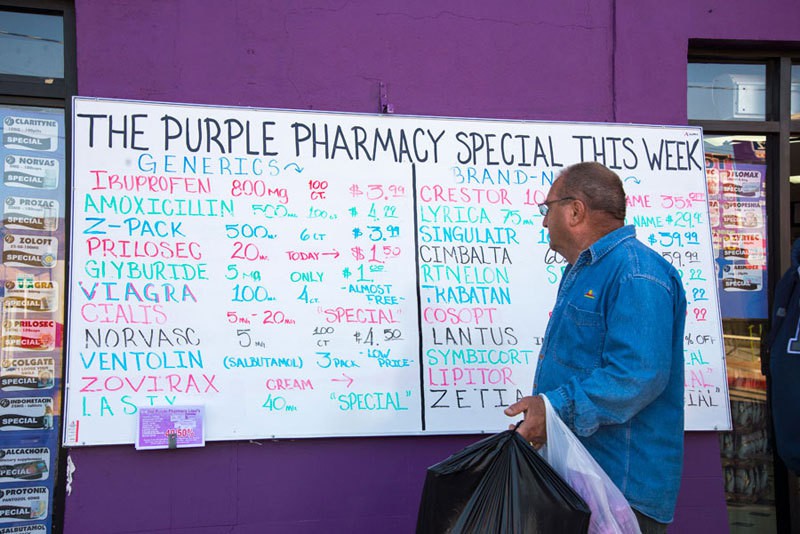Americans Find Huge Savings From Pharmacies, Dentists Based in Canada and Mexico

Cronkite Borderlands Initiative
LOS ALGODONES, Mexico — It happens in two different worlds, much to the disapproval of the Food and Drug Administration and the approval of citizens’ wallets.
Whether it’s a click of the mouse or a 300-mile day trip, Americans' search for cheaper medicine and health care has crossed borders and gone global.
U.S. citizens are increasingly ordering prescription drugs online from Canada or other countries to try to cut costs.
They are taking trips south to Mexico — to places like Los Algodones, a colorful, bustling town seven miles south of Yuma, Ariz., which claims to have more dentists, doctors and pharmacies in a four-block radius than any place in the world.
But FDA officials say counterfeit drugs and financial risks make these quests dangerous.
Still, folks like Gail and Bob Lang of Covington, Ky., who spend their summers in Gainesville, Fla., are willing to take that chance.
Three years ago, Gail Lang, 70, was experiencing involuntary repetitive movements, seizures and muscle pain. She was diagnosed with tardive dyskinesia, a difficult-to-treat neurological disorder.
Tardive dyskinesia has no known cure, but medications can diminish its symptoms, Bob Lang said. She was prescribed Xenazine, a drug which would stop her body shaking and bring her relief.
But there was one big problem: It cost $9,000 for a 30-day supply of the drug, $112,000 a year.
While Medicare in 2010 offered coverage of most drug expenses over $4,550, Bob Lang said that when he went into Walgreens to buy his wife’s medication, he was told his plan would not cover it.
According to a National Academy of Sciences study, 13.6 percent of government prescription drug insurance plans do not cover Xenazine because it is an orphan drug, which means it is only prescribed for rare diseases. Lang said he did not know why the insurance did not cover his wife’s medicine but he checked back with another pharmacist for the price of Xenazine and got the same high price, which means it was not simply an error of the pharmacy.
Currently, only one manufacturer in the U.S. formulates Xenazine.
“In my wife’s case, she would not have ever been able to afford the one drug that the doctor wanted her to take. There’s no way,” Lang said. “I mean if we sold our house, we might have been able to pay the U.S. pharmacy for two years.”
And so following advice from his wife’s aunt, Lang went online and found Planet Drugs Direct — one of 77 online Canadian pharmacies approved by the Canadian International Pharmacy Association.

Mayor Enrique Navarro sits outside a pharmacy in downtown Los Algodones, Mexico. He said the businesses in his town provide quality health care and medicines for customers from across the border. Photo by Lillian Reid. |
By ordering the prescription through a Canadian pharmacy, the Langs only spend $1,776 a year for Xenazine.
Drug costs account for more than half of all out-of-pocket health care expense for a quarter of nonelderly American families, according to a 2012 study published in Health Affairs.
And in a country with a rapidly aging population, 11.9 percent of U.S. residents were enrolled in a Medicare prescription drug plan in April 2013, according to the government’s Centers for Medicare & Medicaid Services.
But the Obama administration contends that home-based relief is on the way. It says the Affordable Care Act — “Obamacare” — is already helping U.S. residents cut their prescription drug costs.
“In the first 10 months of 2012 alone, almost 2.8 million individuals have saved an average of $677 on prescription drugs,” according to a press release on the website of the U.S. Department of Health & Human Services.
Prices for the 30 most-commonly prescribed drugs in the U.S. are one-third higher than prices for the same medications in Germany or Canada, according to a study from Gerard Anderson, professor of international health at the Johns Hopkins Bloomberg School of Public Health.
Jeremiah Hurley, a professor in the economics department at McMaster University and a member of the Centre for Health Economics and Policy Analysis in Canada, said it’s difficult to predict whether the cost of prescription drugs in the U.S. will significantly decline as the Affordable Care Act is fully implemented.
“The Affordable Care Act was not meant to fix all those problems. Its primary goal was to extend insurance coverage,” Hurley said. “I would not expect the way it’s designed and the way the system is that the Affordable Care will have a huge impact on cost trajectories.”
Americans pay far more for health care than any other industrialized nation, according to an analysis from the Commonwealth Fund. In 2009, health spending consisted of 17.4 percent of the U.S. gross domestic product. The Netherlands was second at 12 percent.
“It’s an inane system, in the sense that there’s all kind of discounts and back-room dealing going on that no one’s aware of,” Hurley said. “Many would agree that it’s not a well-functioning system right now in terms of what prices you pay. Lots of people pay a lot.”
And as the population continues to age, more people will require medication and more extensive health care, said Lee Graczyk, lead organizer for RxRights.org, a coalition that tries to ensure access to international importation of prescription drugs.
According to a Pew Research report, 10,000 people in the U.S. turn 65 every day. As that population increases, the number of chronic diseases will follow and more medications will be needed, Graczyk said.
Ten years ago, ordering prescriptions from the Web was a rare occurrence. Tim Smith, general manager of CIPA, said back then the elderly population would load up on buses and head north or south across the border to save on drugs.
Graczyk said he remembers organizing some of those bus trips in the mid-1990s.
But with the advent of the Internet, the trips were replaced by travels in cyberspace.
Across the southern border of the U.S., the balmy temperatures, cheaper prescriptions and easily accessible dental and medical care has kept medical tourists from the U.S. and Canada coming by the droves.
Los Algodones, Mexico, has been called the “Dental Capital of the World” and with good reason. Ron Vinluan, managing director of Dayo Dental, said the small town boasts 200 dentists.
Byrdi and Dennis Naasz, both 67, traveled to Los Algodones in spring 2012 to buy several medications and to get eyeglasses for Dennis. For example, a face cream, called Retin-A used by their granddaughter in South Dakota, normally costs the family $220, but its generic version in Los Algodones cost $2, they said.
Traveling to Los Algodones can be as much a mini-getaway as a medical and financial necessity.
Outside the Purple Pharmacy, Cesar Solorzano stands on the sidewalk dressed in a neon orange jacket, hair gelled-back and like a carnival barker calls to tourists to go inside the pharmacy, save money, be healthy.
Of course, The Purple Pharmacy requires tourists to obtain prescriptions for their medications of choice, Solorzano said, adding he might just know a way to get around that.
Regardless of how drugs, eyeglasses or root canals are acquired, the town remains bursting with seniors, who file out of clinics with proud smiles and order discount margaritas in the shade of multi-hued umbrellas at El Paraiso.
Angie Metzger lives in Yuma, Ariz. six months out of the year and spends the summer in Tacoma, Wash. She and her husband John cross the border frequently for medications, culture and fun. This time they brought a few friends down to show them around and share how to save money on prescriptions.
“If you ask around you’ll get better prices, and they’ll barter with you,” she said.
Enrique Navarro, the mayor of Los Algodones, said his town offers quality prescriptions, dentistry and optometry that are comparable in quality to services in the U.S.
“All the Americans that come here are ‘tercer edad’ (seniors/elderly), almost 90 percent. They have all the time in the world to come, relax, go to the dentist, buy their medicine, buy glasses — everything is much cheaper and of good quality,” Navarro said in Spanish.
But Connie Jung, acting associate director for policy and communications in the FDA’s Office of Drug Security, Integrity and Recalls, said the risk of obtaining drugs from another country outweighs the benefits.
She said drugs sold outside the U.S. are not approved products and can be counterfeit or use different chemical ingredients. The FDA conducts a rigorous scientific review of drugs manufactured for use in the U.S. and drugs purchased in Canada, Mexico and elsewhere.
“We run the risk of U.S. patients potentially being harmed from these products because we have no idea where they actually came from — we have no idea how they were made. We have no idea what they actually contain,” Jung said.
According to the U.S. Federal Food, Drug, and Cosmetic Act, it is illegal to personally import any drug that is not FDA-approved. However, the law is extremely difficult to regulate and has several clauses that allow for personal importation, including if a person has a serious condition that cannot be treated in the U.S.; a person agrees not to resell the pharmaceutical; and the pharmaceuticals constitute no more than a three-month supply.
“The FDA could barely regulate drugs made in this country, much less try to regulate all that stuff,” said William Hubbard, the former senior associate for policy, planning and legislation at the FDA.

A street sign points to a dental office in Los Algodones, Mexico. The town is a medical tourism destination, but U.S. officials worry about the safety of prescription drugs and medical procedures obtained outside of the U.S. |
Hubbard attempted to introduce the Internet Drug Safety Act in 2000, which would have required a pharmacy selling to U.S. citizens over the Internet to be licensed by a U.S. state.
Numerous bills have arisen in support of and against personal importation. The FDA Safety and Innovation Act was signed into law by the president July 9, 2012 and amends the Federal Food, Drug, and Cosmetic Act to allow the secretary of the Department of Health and Human Services to destroy any adulterated, misbranded or counterfeit drugs.
Graczyk and other personal importation advocates opposed the bill.
Other bills sought to waive the limitation on importation from the Federal Food, Drug, and Cosmetic Act, like the Pharmaceutical Market Access and Drug Safety Act or the Prescription Drug Affordability Act, both introduced and killed in 2011.
Graczyk and others actively involved in RxRights.org say the high prices of prescription drugs in U.S. are the direct result of lobbyist influence. According to research from OpenSecrets.org, the pharmaceutical industry spent $234 million on lobbyists in 2012.
Lang, the consumer who had to turn to Canada mail-orders for his wife’s medication, said he is frustrated by the drug companies’ influence.
“I wouldn’t want to be fighting the U.S. drug companies in this country. They’ve got too much money and too much clout,” Lang said.
While the FDA’s Jung said it is unfortunate that costs for drugs are so high in the U.S., the FDA can’t do much about it. It has no power to set prices. It can only ensure that medications are safe.
“We know that that’s a concern, but the FDA … doesn’t have anything to do with price setting," Jung said. "What we can do is ensure the products are safe and high quality, but also if there are generic alternatives, we try to assure that those are safe and effective as they would provide the same benefits as the brand products that might have a higher price tag."
According to an analysis from the Generic Pharmaceutical Association, Americans saved $192.8 billion on prescription drugs in 2011 by buying the generic product, or $1 billion every other day. Eight in 10 prescriptions purchased in the U.S. are generic.
Still, the savings offered by online pharmacies are significant, Smith said. Those who purchase pharmaceuticals through members of Canadian International Pharmacy Association can save 30 to 80 percent off the price they would pay for the medication in the U.S., Smith said.
CIPA regulates 14 members comprised of 77 websites that function as international pharmacies shipping prescription drugs to American customers.
All of the pharmacies regulated by CIPA are licensed where they operate, the majority of which are in Manitoba or British Columbia. However, some CIPA pharmacies are not Canadian and are licensed in countries like Australia, the United Kingdom, New Zealand and Singapore.
Smith said he requires all the CIPA members to be transparent about where they ship their medications, and the association observes the supply chain carefully. All customers must have a prescription, which they fax to the pharmacy.
“We make sure that everything is completely safe and completely secure for our patients," Smith said. "And safety is the number one priority that we have."
Jung and Smith both said some online sellers masquerade as Canadian companies to gain the trust of Americans. But often the product will be shipped from opposite ends of the world, like India, Israel and Costa Rica.
In one 2005 FDA operation called “Bait and Switch,” 85 percent of drugs purportedly shipped from Canada originated from 27 other countries around the world.
Lang orders two medications from Planet Drugs Direct for his wife, one which comes from Germany, Symbalta, and the Xenazine, which arrives from Singapore.
According to the online pharmacy’s website, it has a licensed pharmacy in Canada and several other international pharmacies. It also says it has a toll-free support line based in Vancouver, Canada. However, Lang said when he called the customer service department for Planet Drugs Direct, he spoke to someone at a facility in Texas.
“When the people answer the phone, they don’t speak like a Canadian," Lang said. "I got a lot of Canadian friends, eh? And they don’t sound like Canadians. They just sound like you and I."
Websites that deal in counterfeit products or lie about the origin of the medication are equally loathed by the FDA, RxRights and CIPA.
Counterfeiters will often start up a website, send out some drugs, and then start up another site elsewhere, Jung said. If the counterfeiters stayed under the same name for sales, they would lose business and risk being caught.
“Counterfeiters, they don’t really care about your health. They don’t really care about what happens to the buyer. And so, they’re gonna cut corners," Jung said. "And so that’s why they’re often able to provide a product that’s a cheaper price."
Lang said he understands the risks, but believes that a bit of research and trust will result in money well spent.
“There’s a lot of junk, buyer beware. You know you just have to be careful about what you run into these days because you just don’t know who to trust,” Lang said.
Cronkite’s Harmony Huskinson reported from Los Algodones, Mexico, and Ontario, Canada, for this report. Back to Top




